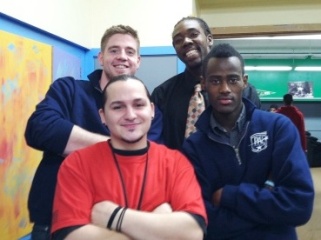 Joe Mcferrin (L) with POIC supporter Marc A. Alexander, director of the Technology learning Group at Intel Capital at the school's annual work opportunities breakfast Joe Mcferrin (L) with POIC supporter Marc A. Alexander, director of the Technology learning Group at Intel Capital at the school's annual work opportunities breakfast |
East Portland will get a new high school this fall.
Portland Opportunities Industrial Center is set to open Rosemary Anderson High School East, to work with students who need an alternative to their neighborhood high school to help them graduate.
The alternative high school will give a fresh face to Rockwood Plaza, currently a strip mall at 183nd Avenue and S.E. Division St. The school will work in partnership with Gresham-Barlow and Centennial school districts to replicate POIC's successful alternative high school in North Portland.
"Their data regarding graduation rates, and the data on students who continue into training and paid employment, was impressive," says Janell Black, director of student support services at Gresham-Barlow.
"We know that for some students our comprehensive large schools are not meeting their needs. We know that from data and reports from our schools."
Rosemary Anderson High School works with students who drop out or fail to succeed at other high schools, offering mentoring and wrap around family support as well as academic challenge.
"What we do is we engage high school dropouts," says Joe McFerrin, President and CEO of POIC. ""We do that through relationship building; project-based learning; employment training, exposure and placement. Most importantly, the key to our success is we help them address the barriers they face in their personal life."
Based on the 200 students currently attending POIC's North Portland high school, those barriers will include: homelessness, poverty, and family breakdown. One in four current Rosemary Anderson students is either in foster care or homeless.
"Once we inspire them and get them back on track for success, we stay with them until they are 25," McFerrin says. "We're looking for long-term relationships with young people that result in individuals who are educated, connected and can be self-sufficient, and ultimately give back and help others."
Students who drop out of high school find their career opportunities are blocked. And they are at far higher risk of falling prey to drug abuse, or getting involved in crime. Advocates have named this vicious cycle the 'Pipeline to Prison'. POIC works to break the cycle by helping students overcome the problems that have stalled their academic progress.
According to Worksystems, one in six Oregon youth aged 16-24 are now not in school or working.
POIC gives each student a full assessment. Testing sometimes shows students have been battling unnoticed with minor and treatable learning disabilities. Social service assessments show the majority are dealing with severe family stressors. With the right support, most POIC students can and do succeed. Some excel in higher education; others do well in business or as employees.
The plan came about after Centennial's student services director approached McFerrin to discuss how to help the district's high-risk students. That was last October. Six months and 10 meetings later, the new alternative school now has funds, a curriculum and contracts to serve 100 Centennial and Gresham-Barlow students in its first year. That number likely will expand to 175 or 200 in 2013-14.
McFerrin says he already had been thinking of how to help the growing number of disadvantaged, often minority, students swelling the numbers in East County. East Portland is home to 25 percent of all Portland residents and to a higher percentage of the county's children and youth, many of them youth of color and immigrants who speak languages other than English at home. Poverty is higher in East Portland and resources are scarcer.
 Jay Williams, who leads the Eastside PAL youth center, (back right) pictured with a few of his staff members Jay Williams, who leads the Eastside PAL youth center, (back right) pictured with a few of his staff members |
That's one reason why POIC has made another key partnership – with the nonprofit Police Activities League (PAL). PAL's youth center on 162nd and N.E. Glisan serves about 200 low-income children and teens every day, in its after-school enrichment and recreation programs, as well as over the summer and spring break.
"I'm very excited to partner with PAL," McFerrin says. "They are doing a very good job of attracting a lot of young people during non-school hours. They have a wonderful staff, a staff that really cares, working under Jay Williams. They have a lot to offer including volunteer opportunities and training for our students.
"I just see kids connected from 8 a.m. to 8 p.m. at night. I look at PAL as an extension of our school."
Introduced by Antoinette Edwards, director of the city's Office of Youth Violence Prevention, McFerrin and PAL's executive director, Patricia Day TenEyck have been putting their heads together to figure out how to raise the money needed to upgrade the youth center.
Unlike PAL's Westside building, the Eastside youth center is in serious need of repair and resources. Only a couple of computers are available for students to do schoolwork. Jay Williams says he needs books and decent furniture, as well as repairs to holes in the gymnasium wall, and new carpet. The current flooring is thought to contain asbestos. And those are just the most urgent resource issues.
POIC has earmarked $20,000 from its general account to help with the repairs.
"Patricia and I are together going to find some additional resources," McFerrin says. "We both have secured some funding. I'm guessing we need about $40,000 more."














































































































































































































































































































